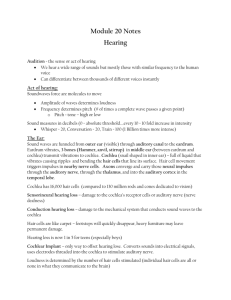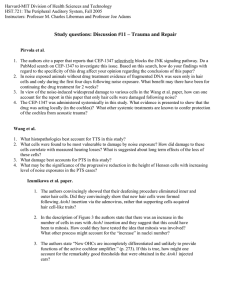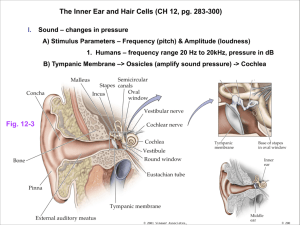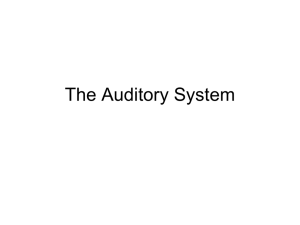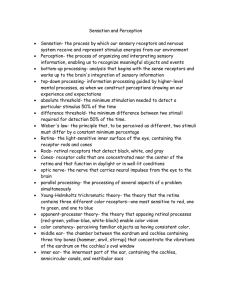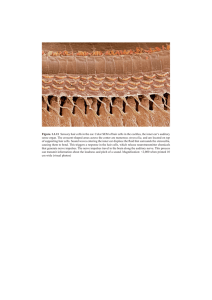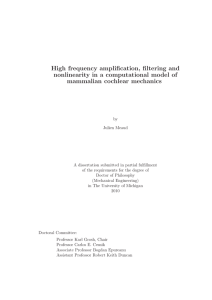Harmonicity Winner-Take-All
advertisement
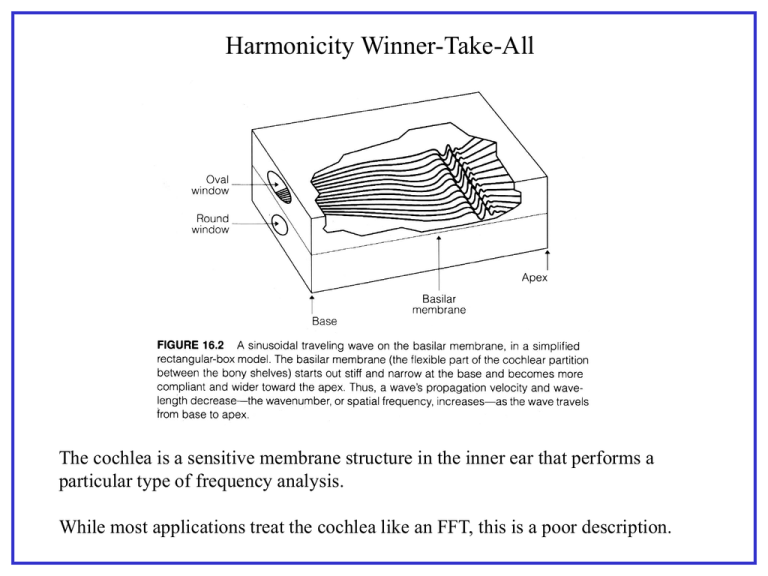
Harmonicity Winner-Take-All The cochlea is a sensitive membrane structure in the inner ear that performs a particular type of frequency analysis. While most applications treat the cochlea like an FFT, this is a poor description. The point is that for a given input frequency, many points on the cochlea respond, but With different amplitudes and different phases. 1) While it is true that the cochlea extracts frequency, the tuning is broad. 2) Unlike the FFT and spectrogram representations, frequency tuning is found logarithmically represented along the length of the cochlea and in the hair cell population. 3) At the frequencies for much of speech, the hair cells in the cochlea can report the relative phases of the waveform for a particular frequency Linear vs. Log Frequency Coding Harmonic sounds Spectrogram 2.2kHz Cochleagram 200 120 180 160 100 140 80 120 100 60 80 40 60 40 20 20 5 10 15 20 time 25 30 35 40 100 200 300 400 time 500 600 140 120 120 100 100 80 80 60 60 40 40 20 20 0 20 40 60 80 100 120 140 160 0 0.5 1 1.5 2 2.5 3 3.5 4 0. 7 0. 6 0. 5 0. 4 0. 3 0. 2 time 0. 1 0 0 20 40 60 80 100 120 140 160 180 Because many phases of a tone are found in the cochlear representation, a harmonic sound will excite a subset of cochlear hair cells to fire in synchrony at a period equal to the fundamental frequency. cos(x), cos(2x), cos(3x) 1 0.8 0.6 0.4 0.2 0 -0.2 -0.4 -0.6 -0.8 -1 0 2000 4000 6000 8000 10000 12000 Hair cells from the cochlea - different best frequencies Inhibitory neuron Hair cells from the cochlea - different best frequencies Inhibitory neuron By making the inhibitory neuron leaky, temporally-jittered inputs leak away before their contributions add up. When synchronized inputs come in, those neurons fire together, driving the inhibitory neuron at the same time. This barrage of inputs make the inhibitory cell fire immediately. The inhibitory cell then shuts everyone down. Only the synchronized pattern gets through. Two harmonic sounds summed 120 100 80 60 40 20 20 40 60 80 100 120 Can we pull these apart? 140 160 Chip Idea: 1. Given a cochlea circuit in PSPICE, design the hair cells and inhibitory network neurons and demonstrate the synchrony concept. 2. Show that harmonic sounds are preferentially passed through and that the network can briefly lock onto one harmonic sound over another.
